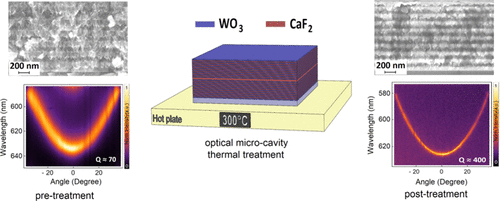当前位置:
X-MOL 学术
›
ACS Appl. Nano Mater.
›
论文详情
Our official English website, www.x-mol.net, welcomes your feedback! (Note: you will need to create a separate account there.)
Highly Reflective Periodic Nanostructure Based on Thermal Evaporated Tungsten Oxide and Calcium Fluoride for Advanced Photonic Applications
ACS Applied Nano Materials ( IF 5.9 ) Pub Date : 2020-10-29 , DOI: 10.1021/acsanm.0c02206 Marco Pugliese 1, 2 , Carmela Tania Prontera 1 , Laura Polimeno 2 , Giovanni Lerario 1 , Roberto Giannuzzi 1 , Marco Esposito 1 , Sonia Carallo 1 , Daniele Costa 2 , Luisa De Marco 1 , Milena De Giorgi 1 , Giuseppe Gigli 1, 2 , Daniele Sanvitto 1 , Vincenzo Maiorano 1
ACS Applied Nano Materials ( IF 5.9 ) Pub Date : 2020-10-29 , DOI: 10.1021/acsanm.0c02206 Marco Pugliese 1, 2 , Carmela Tania Prontera 1 , Laura Polimeno 2 , Giovanni Lerario 1 , Roberto Giannuzzi 1 , Marco Esposito 1 , Sonia Carallo 1 , Daniele Costa 2 , Luisa De Marco 1 , Milena De Giorgi 1 , Giuseppe Gigli 1, 2 , Daniele Sanvitto 1 , Vincenzo Maiorano 1
Affiliation

|
In this paper, we report the fabrication and characterization of high-quality distributed Bragg reflectors (DBRs) deposited by low-energetic thermal evaporation. This technique allows deposition of high-quality thin films with an accurate control of thickness at the nanoscale. We investigated, for the first time, the use of tungsten oxide (WO3) and calcium fluoride (CaF2) as high (2.15) and low (1.4) refractive index materials, respectively, for DBR fabrication. They consist of nine pairs of WO3/CaF2 layers, with a central wavelength λc tuned at 640 nm and a maximum reflectance of 99.6%. A passive microcavity consisting of a λ/2 thick spacer of CaF2 sandwiched between 8.5 pairs of WO3/CaF2 has also been fabricated. We investigated the optical behavior of this microresonator after post-deposition thermal treatment at different temperatures, showing a blue shift of the resonant mode and an increase in its intensity. Indeed, heat treatment induced a compaction of the DBR multilayer, leading to more defined and clearer interfaces, as demonstrated by scanning electron microscopy cross section measurements. This behavior results in an improvement of the microcavity quality factor (up to 400) as the temperature increases, which is currently the highest value obtained for microcavities obtained by thermal evaporation processes, so far. These results represent a further step forward toward the development of high-reflectivity mirrors and high-quality microresonators fabricated by the low-energy deposition technique. Such a structure could find extensive application in nano-photonics, optoelectronics, and sensors, even based on soft organic materials.
中文翻译:

基于热蒸发氧化钨和氟化钙的高反射周期性纳米结构,用于高级光子应用
在本文中,我们报告了通过低能热蒸发沉积的高质量分布式布拉格反射器(DBR)的制造和表征。该技术允许沉积高质量薄膜,并在纳米级精确控制厚度。我们首次研究了使用氧化钨(WO 3)和氟化钙(CaF 2)作为高折射率材料(2.15)和低折射率材料(1.4)分别用于DBR制造。它们由九对WO 3 / CaF 2层组成,其中心波长λc调整为640 nm,最大反射率为99.6%。由λ/ 2厚的CaF 2间隔层组成的无源微腔夹在8.5对WO 3 / CaF 2之间也被捏造了。我们研究了此微谐振器在不同温度下的沉积后热处理后的光学行为,显示了谐振模的蓝移和强度的增加。的确,如通过扫描电子显微镜横截面测量所证明的,热处理引起了DBR多层的致密化,从而导致界面更加清晰和清晰。这种行为导致随着温度的升高,微腔品质因数的改善(最高400),这是迄今为止通过热蒸发工艺获得的微腔所获得的最高值。这些结果代表了通过低能量沉积技术制造的高反射率镜和高质量微谐振器的进一步发展。
更新日期:2020-11-25
中文翻译:

基于热蒸发氧化钨和氟化钙的高反射周期性纳米结构,用于高级光子应用
在本文中,我们报告了通过低能热蒸发沉积的高质量分布式布拉格反射器(DBR)的制造和表征。该技术允许沉积高质量薄膜,并在纳米级精确控制厚度。我们首次研究了使用氧化钨(WO 3)和氟化钙(CaF 2)作为高折射率材料(2.15)和低折射率材料(1.4)分别用于DBR制造。它们由九对WO 3 / CaF 2层组成,其中心波长λc调整为640 nm,最大反射率为99.6%。由λ/ 2厚的CaF 2间隔层组成的无源微腔夹在8.5对WO 3 / CaF 2之间也被捏造了。我们研究了此微谐振器在不同温度下的沉积后热处理后的光学行为,显示了谐振模的蓝移和强度的增加。的确,如通过扫描电子显微镜横截面测量所证明的,热处理引起了DBR多层的致密化,从而导致界面更加清晰和清晰。这种行为导致随着温度的升高,微腔品质因数的改善(最高400),这是迄今为止通过热蒸发工艺获得的微腔所获得的最高值。这些结果代表了通过低能量沉积技术制造的高反射率镜和高质量微谐振器的进一步发展。



























 京公网安备 11010802027423号
京公网安备 11010802027423号